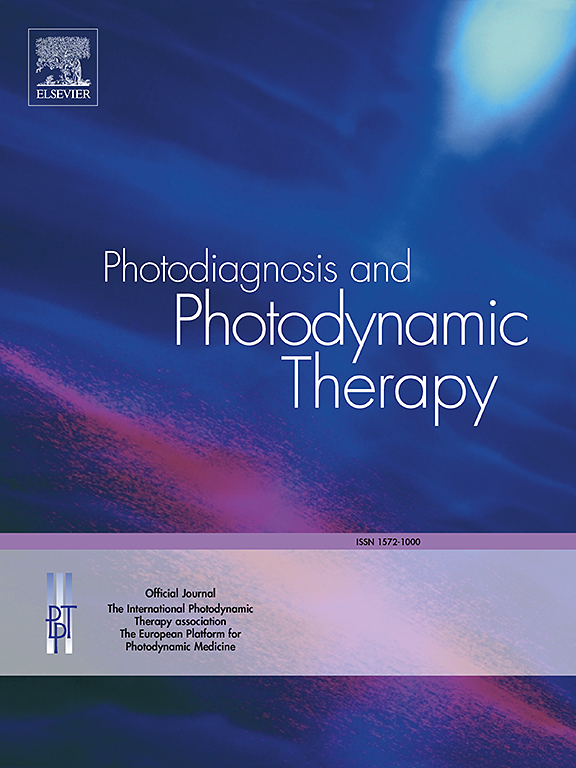Photobiomodulation therapy at 650 nm enhances osteogenic differentiation of osteoporotic bone marrow mesenchymal stem cells through modulating autophagy
IF 3.1
3区 医学
Q2 ONCOLOGY
引用次数: 0
Abstract
Background
Photobiomodulatiom therapy (PBMT) has biostimulatory effects on bone marrow mesenchymal stem cells (BMSCs), which takes a pivotal role in maintaining bone mass and avoiding osteoporosis (OP). Autophagy is an important regulator for cell survival and homeostasis. Previous researchers found that BMSCs derived from osteoporotic rats (OP-BMSCs) were with the feature of reduced osteogenic differentiation and autophagy dysfunction. However, the potential regulation of PBMT in osteogenic differentiation of OP-BMSCs and its underling relationship with autophagy remain unclear.
Methods
650 nm red light-emitting diode (LED) was selected to initiate PBMT effects. The isolation and culture of OP-BMSCs were implemented after the establishment of the OP rat model. Firstly, the optimal dose of LED was screened on OP-BMSCs by CCK-8. Meanwhile, the osteogenic and mineralization activities were studied through the detection of Alkaline phosphatase (ALP) and alizarin red S (ARS). Then, the levels of osteogenesis and autophagy were investigated via western blot and immunofluorescence staining. Finally, the autophagy inhibitor 3-MA was applied to illustrate the underlying mechanism of the osteogenic effect of PBMT on OP-BMSCs.
Results
Firstly, the optimal dose of 6 J/cm2 LED was selected in the subsequent experiments according to CCK-8. Then, the ALP activity and the mineralization ability of OP-BMSCs were obviously increased by PBMT. Meanwhile, Runx-2, OCN and OPN were significantly upregulated in LED group. Furthermore, the expressions of autophagic proteins increased significantly in LED group by immunofluorescence staining and western blot assay. At last, the promoted effects of PBMT on osteogenic differentiation in OP-BMSCs were distinctly reversed via inhibiting autophagy.
Conclusion
Our research illustrated that 650 nm LED could improve osteogenic differentiation of OP-BMSCs, suggesting a potential correlation between PBMT-mediated activation of autophagy and promotion of osteogenic differentiation.
650 纳米波长的光生物调节疗法通过调节自噬增强骨质疏松症骨髓间充质干细胞的成骨分化。
背景:光生物调节疗法(PBMT)对骨髓间充质干细胞(BMSCs)具有生物刺激作用,而骨髓间充质干细胞在维持骨量和避免骨质疏松症(OP)方面发挥着关键作用。自噬是细胞存活和平衡的重要调节因子。之前的研究发现,骨质疏松症大鼠的 BMSCs(OP-BMSCs)具有成骨分化能力下降和自噬功能障碍的特点。方法:选择650 nm的红色发光二极管(LED)来启动PBMT效应。在建立 OP 大鼠模型后,进行 OP-BMSCs 的分离和培养。首先,通过CCK-8筛选出LED对OP-BMSCs的最佳剂量。同时,通过检测碱性磷酸酶(ALP)和茜素红 S(ARS)来研究成骨和矿化活性。然后,通过 Western 印迹和免疫荧光染色研究了成骨和自噬的水平。最后,应用自噬抑制剂 3-MA 来说明 PBMT 对 OP-BMSCs 成骨作用的内在机制:首先,根据CCK-8,在随后的实验中选择了6 J/cm2 LED的最佳剂量。结果:首先,根据 CCK-8 在后续实验中选择了 6 J/cm2 LED 的最佳剂量,然后,PBMT 明显提高了 OP-BMSCs 的 ALP 活性和矿化能力。同时,Runx-2、OCN和OPN在LED组中明显上调。此外,通过免疫荧光染色和Western blot检测,LED组自噬蛋白的表达也明显增加。最后,通过抑制自噬,PBMT 对 OP-BMSCs 成骨分化的促进作用被明显逆转:我们的研究表明,650 nm LED 可改善 OP-BMSCs 的成骨分化,这表明 PBMT 介导的自噬激活与成骨分化促进之间存在潜在的相关性。
本文章由计算机程序翻译,如有差异,请以英文原文为准。
求助全文
约1分钟内获得全文
求助全文
来源期刊

Photodiagnosis and Photodynamic Therapy
ONCOLOGY-
CiteScore
5.80
自引率
24.20%
发文量
509
审稿时长
50 days
期刊介绍:
Photodiagnosis and Photodynamic Therapy is an international journal for the dissemination of scientific knowledge and clinical developments of Photodiagnosis and Photodynamic Therapy in all medical specialties. The journal publishes original articles, review articles, case presentations, "how-to-do-it" articles, Letters to the Editor, short communications and relevant images with short descriptions. All submitted material is subject to a strict peer-review process.
文献相关原料
公司名称
产品信息
索莱宝
Alizarin Red S (ARS)
阿拉丁
cetylpyridinium chloride (CPC)
 求助内容:
求助内容: 应助结果提醒方式:
应助结果提醒方式:


